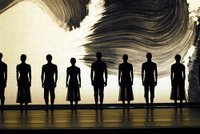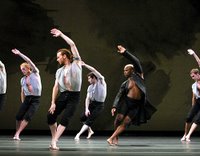 Sept 21, 2007
Sept 21, 2007Zellerbach Hall, UC Berkeley
I worry when a choreographer makes a full-evening length dance that works--one that's not a story-ballet or a polemic, that can keep an audience focussed and not fidgeting in their seats as you begin section 11 of a 12-part work.
Aw, hell, I think to myself, now every yahoo is going to think that they're as skilled as Mark Morris -- that they can pull off a whole night's worth of abstract modern dance just like "Mozart Dances," which had its West Coast premiere at Zellerbach Hall at UC Berkeley recently. He makes little things like organic form and reformed structure look too easy.
Facetiousness aside, however, Morris impressively leads the audience on an engaging excursion through a beautiful three-act work set to Mozart's Piano Concerto No. 11 in F Major, his Sonata in D major for Two Pianos, and his Piano Concerto No 27 in B-flat Major.
To call it ambitious would be patronizing. Morris is too canny a dancemaker to attempt a large scale work without thinking through the nuts and bolts and "ambitious" implies a certain amount of failure in the very word. "Mozart Dances" is not my favorite of his works-- I reserve that title for his exhilarating "L'Allegro"-- but it is both satisfying and successful on a grand scale.
The tone here is simple rituals, with shades of 18th century airs and graces, reflected in Martin Pakledinaz's black and blue-gray knee breeches for the men and diaphanous dresses for the women. Broken into a section mainly for women ("Eleven"), one mainly for men ("Double") and one for a happy intermingling of both genders ("Twenty-seven"), Mozart Dances seems to allude to everything and nothing. A wry comedy of manners? Sistahs doing it for themselves? Menacing, dangerous liaisons?
 Morris famously admires the work of George Balanchine, and there's several "Serenade"-like moments of scattered throughout the evening -- the dramatic, plunging swoon to the floor, the gauzy moonlight skirts of the women during their brief interlude in "Double," the second act of the evening.
Morris famously admires the work of George Balanchine, and there's several "Serenade"-like moments of scattered throughout the evening -- the dramatic, plunging swoon to the floor, the gauzy moonlight skirts of the women during their brief interlude in "Double," the second act of the evening.And yet it wasn't Balanchine that "Mozart Dances" evoked for me, but rather the earlier grittier "Les Noces," by Bronislava Nijinska, circa 1923. It wasn't the score -- Mozart is rather different from the pounding, earthiness of Stravinsky's peasant wedding -- but rather the look of things.
The stark force of Howard Hodgkin's curtailed, painterly brush-strokes-- writ-gargantuan on the cyc in the back-- the architectural groupings and waving of the women in "Eleven" recalled the severe austerity of Nijinska to my eye. Almost certainly, Morris had no intention of evoking a Nijinska's broadly-drawn modernist ballet, but all the same, my mind, grasping for narrative threads, settled on this one.
That there is a ritual feeling throughout "Mozart Dances" is no surprise, given Morris' mastery of the folk dance forms. The weaving patterns of the women as they wound in and out of Lauren Grant's dance in "Eleven" called up the braiding of the bride's hair in "Les Noces'" first tableau. Two poignant solos for other women brought to mind the lamenting mothers of the third tableau. And then the mixture of dreamy sentiment and manly urgency in "Double" made me think of the Consecration of the Groom scene. By the time the curtain rose on Hodgkin's final image -- this time featuring an angry red swath across the space, like virginal blood displayed on the wedding sheets -- I was sure I had the story nailed.
 Am I way off-base with my Russian Peasant Wedding theory? Almost assuredly. Reviewing the "Mozart Dances" in the New Yorker, Joan Acocella reports that Morris himself cites the madcap ending of Mozart's opera buffa "Cosi fan tutte." Fair enough. Mozart's pretty far from Russia.
Am I way off-base with my Russian Peasant Wedding theory? Almost assuredly. Reviewing the "Mozart Dances" in the New Yorker, Joan Acocella reports that Morris himself cites the madcap ending of Mozart's opera buffa "Cosi fan tutte." Fair enough. Mozart's pretty far from Russia.It doesn't stop me from secretly clinging to my theory. After all, that's the flexible pleasure of abstraction. Choose your story and run with it.
For more information, check out cal Performances' extensive webpage on the event with links to video clips and program notes.

No comments:
Post a Comment